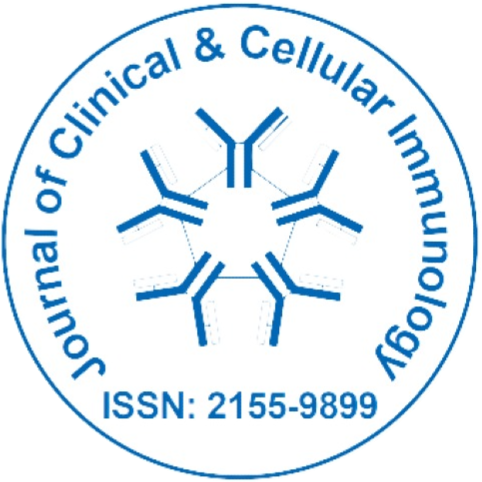
Journal of Clinical and Cellular Immunology
Open Access
ISSN: 2155-9899

ISSN: 2155-9899
Perspective - (2024)Volume 15, Issue 6
The immune system in humans plays a critical role in protecting the body from pathogens and tumors while maintaining tolerance to self-antigens. However, immune responses must be tightly regulated to prevent damage to healthy tissues and this balance is achieved through mechanisms such as regulatory T cells and immune checkpoint inhibitors. These regulatory systems are essential for avoiding chronic inflammation, which could otherwise lead to tissue damage. Immune responses also significantly influence the effectiveness of gene and cell therapies, where both beneficial and adverse immune reactions can occur. For example, the immune system can recognize therapeutic components, such as vectors or gene products, and eliminate them or induce toxic responses, leading to the failure of treatment. Conversely, gene and cell therapies can be designed to either promote immune tolerance or activate immune responses against tumors, offering a potential avenue for therapeutic innovation.
A range of challenges related to immune responses in gene and cell therapies has emerged, as highlighted in recent reviews. One of the major obstacles in gene therapies, especially those utilizing Adeno-Associated Viruses (AAV), is the immune response triggered by the vector and its components. Immune responses can arise from both innate and adaptive immune mechanisms. Innate immunity, involving pattern recognition receptors like Toll-Like Receptors (TLRs), plays a significant role in modulating the adaptive immune response to the vector and its therapeutic gene product. Understanding these interactions has revealed important insights into the immune mechanisms that contribute to the success or failure of gene therapies.
Further challenges arise when considering the immunogenicity of gene therapies, which may differ depending on the target tissue, the method of vector delivery and the patient’s prior exposure to recombinant proteins. Research has shown that inducing immune tolerance to the therapeutic gene product is a critical factor in achieving long-lasting benefits. This has been particularly evident in liver-targeted gene therapies, where tolerance to the therapeutic protein has been observed, although such tolerance is also seen in other tissues.
In addition to viral-based gene therapies, ex vivo genetically modified Hematopoietic Stem Cells (HSCs) are being discovered for a variety of genetic disorders, such as immune deficiencies and hemoglobinopathies. These therapies have shown great ability and are expected to be approved for clinical use following successful phase III trials. However, the immune response to these modified cells presents challenges. In some cases, immune suppression is required to prevent rejection of the modified cells or to mitigate inflammatory responses, especially in patients with diseases that inherently involve immune dysregulation.
Another breakthrough in immunotherapy is the use of Chimeric Antigen Receptor T cells (CAR T cells). These engineered T lymphocytes have demonstrated exceptional potential in treating cancers, particularly with the approval of Cluster of Differentiation 19 (CD19) Chimeric Antigen Receptor T cell therapies for certain types of leukemia and lymphoma. The development of CAR T cells involves collecting a patient’s T lymphocytes, genetically modifying them to express a receptor that targets specific tumor-associated antigens and then reintroducing these modified cells into the patient’s body. Challenges in CAR T cell therapy include ensuring consistency in manufacturing processes and improving the persistence and potency of the modified cells to enhance therapeutic outcomes across diverse patient populations.
Oncolytic Virus (OV) therapies are another innovative approach that harnesses the natural ability of viruses to kill cancer cells while also stimulating a broader immune response against tumors. Oncolytic viruses, such as adenoviruses, are genetically engineered to enhance their tumor-killing capabilities while minimizing damage to normal tissues. These viruses can be further modified to boost their immunogenicity, potentially making them more effective in treating tumors and overcoming the immunosuppressive tumor microenvironment. In fact, the first-ever gene therapy product for treating head and neck cancers, based on an oncolytic adenovirus, was approved in China, highlighting the potential of these therapies.
The field of immunotherapy is rapidly advancing, with a growing understanding of how immune responses can be harnessed or modulated to improve gene and cell therapies. Although there are still challenges to overcome, particularly in managing immune responses, the potential for these therapies to transform the treatment of genetic disorders and cancer is vast. Further research into immune tolerance, cell-based therapies and viral therapies is essential to unlocking the full potential of these cutting-edge treatments.
Citation: Hall D (2024). Influence of Toll-Like Receptors on AAV-Based Gene Therapies. J Clin Cell Immunol. 15:742.
Received: 21-Oct-2024, Manuscript No. JCCI-24-36440; Editor assigned: 23-Oct-2024, Pre QC No. JCCI-24-36440 (PQ); Reviewed: 07-Nov-2024, QC No. JCCI-24-36440; Revised: 14-Nov-2024, Manuscript No. JCCI-24-36440 (R); Published: 21-Nov-2024 , DOI: 10.35248/2155-9899.24.15.742
Copyright: © 2024 Hall D. This is an open-access article distributed under the terms of the Creative Commons Attribution License, which permits unrestricted use, distribution and reproduction in any medium, provided the original author and source are credited.